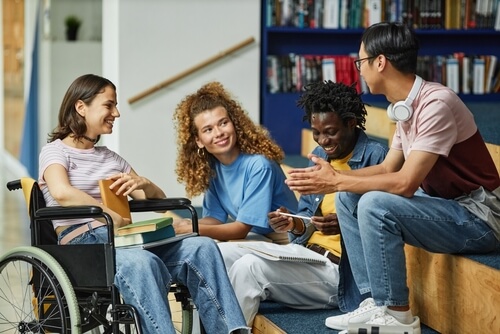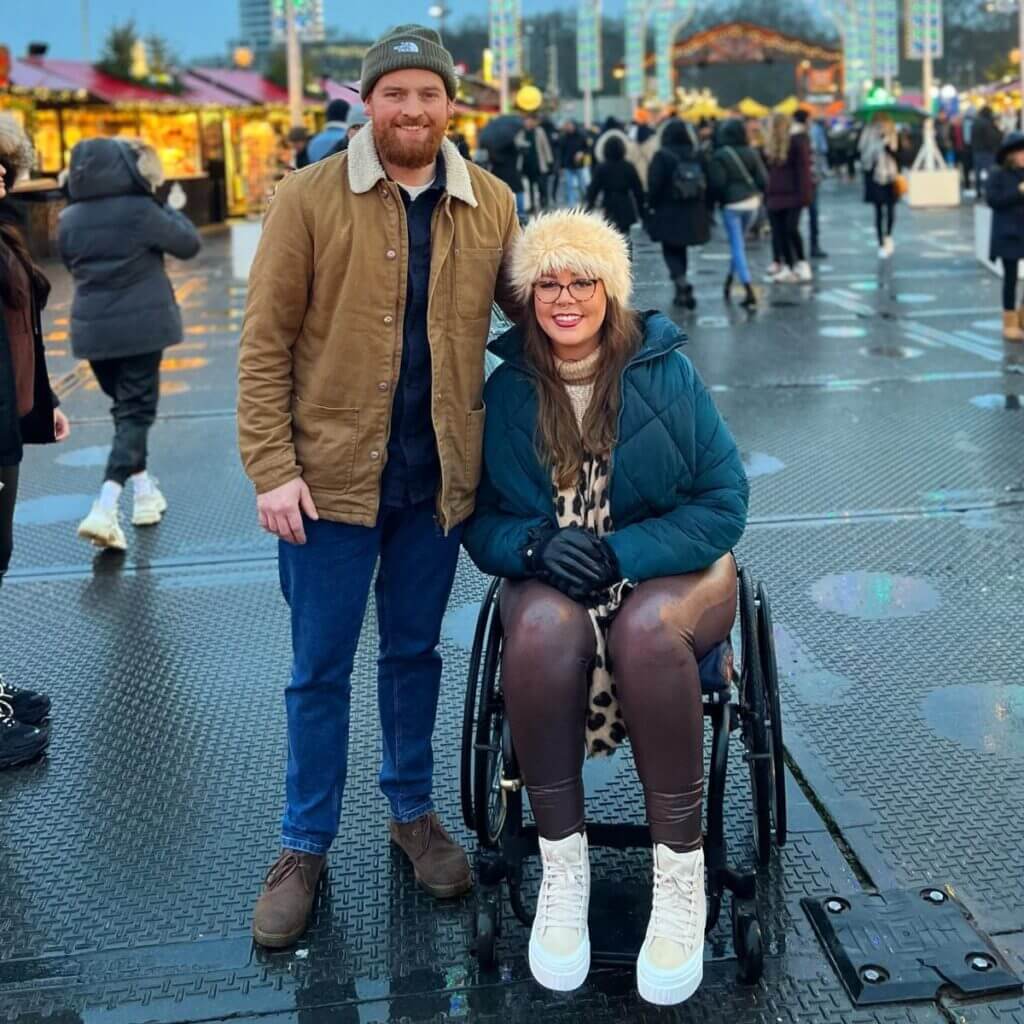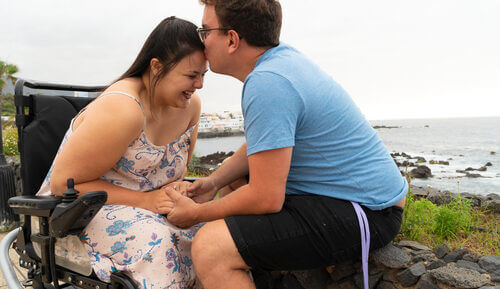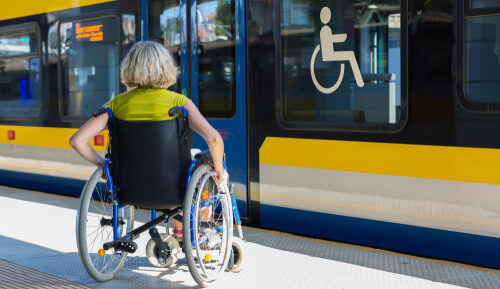
Page contents
- What is ableism?
- Discrimination based on disability
- Examples of ableism
- How can ableism be challenged?
- Be aware of stereotypes
- Examples of ableism stereotypes
- Engage with the disabled community
- Understand the physical barriers
- Educate yourself about ableism
- Jennie's experience: 'Society isn't always accessible'
- What is internalised ableism?
- What is disablism?
- Help and support
Page contents
- What is ableism?
- Discrimination based on disability
- Examples of ableism
- How can ableism be challenged?
- Be aware of stereotypes
- Examples of ableism stereotypes
- Engage with the disabled community
- Understand the physical barriers
- Educate yourself about ableism
- Jennie's experience: 'Society isn't always accessible'
- What is internalised ableism?
- What is disablism?
- Help and support
What is ableism?
What is ableism and how can you challenge it? It’s no secret people with disabilities often face a very different reality to those who are not disabled. This article highlights details of this type of discrimination and examples of ableism.
From employment and housing to everyday trips out to the shop, there are a multitude of obstacles that can prevent you as a disabled people from living the life you want, and have the right to live.
There is still lots of work to be done to achieve societal equality for you as a disabled person. A great place to start is with people’s attitudes.
Discrimination based on disability
Ableism refers to discrimination based on disability. It is any practice that devalues and discriminates against people with physical, intellectual, or psychiatric disabilities. It is centred on the idea non-disabled people are more valuable to society than disabled people.
This can manifest in different ways and on different levels of severity, from a minor inconvenience through to a complete barrier to accessing things that every person should have a right to.
Examples of ableism
Some examples of ableism include:
- Discrimination in education or employment. For example, schools or employers not making reasonable adjustments for a disabled person, or biasness against disabilities.
- Inaccessible designs, Such as a building with no access for a wheelchair, or a music event with no designated space for disabled attendees. Accessibility can also involve lighting and noise.
- Ableist language. For example, using ‘OCD’ to describe someone who is particularly tidy, diminishes OCD as a serious condition.
- Able-bodied people using facilities that are made for disabled people, such as parking spaces or bathrooms.
- Asking a disabled person what is “wrong” with them.
- Making judgements of a person based on their disability, for example talking to the person with a disabled person rather than the disabled person themselves.
- Telling a disabled person they don’t look disabled, or that you don’t “see” their disability.
- Assuming disabled people do not engage with ‘normal’ parts of society, such as work or relationships, and seeing them as “inspirational” if they do so.*
Each of the examples above can have a major impact on how you as a disabled person experiences the world.
*WeThe15 (launched in 2021) is a worldwide movement aiming to initiate change over the next 10 years to eradicate inequality for disabled people. Part of this movement is based on raising awareness of the normalcy of being disabled.
How can ableism be challenged?
The growing understanding of ableism shows us that progress is being made. But there is still some way to go before we reach a completely accessible and equal society.
The good news – there are plenty of ways for us all to play our part.
Be aware of stereotypes
Stereotypes refer to prejudgements based on what we think we know about a person, or a group of people. These prejudgements can be unique to us, or based on a wider common perception.
When it comes to disability, the most common stereotype is that disabled people’s capabilities are lesser than those of able-bodied people. What a disabled person can or cannot do cannot be determined by their disability.
These kind of stereotypes can also lead to harsher misjudgements related to a person’s wider lifestyle.
Examples of ableism stereotypes
- Disabled people cannot, or do not, work.
- Disabled people do not have fulfilling relationships.
- Disabled people are not able to have a social life.
- Disabled people need additional assistance wherever they go.
These stereotypes are detrimental to how people with disabilities are seen and treated by society. They often prevent the disabled community from being included in social discourse.
Unfortunately, negative ideas about disabilities are so much an inherent part of how society sees disabled people . Individuals may not notice the negative impact these stereotypes have, even if you are a disabled person yourself.
To challenge this, try to be hyper aware of your instant thought process when in certain situations and consider whether this is kind, fair, or even helpful. If not, then consider how this thought process can be changed.
Engage with the disabled community
Unless you are a disabled person yourself, or have a relative or friend who has a disability, it can be difficult to understand how damaging ableist attitudes can be. Engaging with disabled people will help you to better understand their perspective and see first-hand the obstacles they can face.
Even if you are a disabled person, you still might benefit from spending more time with the community to learn about the experiences of other disabled people, and how you can help your own community to be seen.
It’s also important to remember that every disabled person won’t have the same experience or ideas.
For example, many disabled people are working to reclaim the word ‘disabled’ and prove that it isn’t something negative or to be avoided. Some people would prefer not to be called disabled. These preferences can only be determined by speaking directly with the people who they affect.
Disabled people should have the loudest voice in the disabled space, so the more people you speak to the better.
Understand the physical barriers
The internal thought process formed about disabilities or disabled people can manifest into a range of physical barriers which prevent you as a disabled people from living your life.
Physical barriers include:
- Being unable to enter a building such as a shop if the adequate features are not available, such as a ramp for a wheelchair.
- Poor access to facilities such as a bathroom (for example, it’s not uncommon for stores to use their disabled bathroom for storage).
- Being unable to use public transport, or finding it very difficult to do so.
Arguably, it is the physical barriers caused by ableism that affect the everyday life of disabled people the most as they make it more difficult, or completely impossible, to carry out everyday tasks. However, it is internal ableism which creates these physical barriers in the first instance.
Understanding how an ableist mindset can physically manifest may make it easier to see how this mindset can be changed.
Educate yourself about ableism
Although engaging with the community is a great way to better understand ableism and how it manifests, the disabled community should not be relied on to educate wider society.
Whether you are a disabled person or not, you should aim to take active steps to educate yourself about ableism, and other experiences of disabled people, rather than hoping that others do the work for you.
There is an abundance of resources available, created by people with differing disabilities, which offer information about discrimination, prejudice and general experiences of the disabled community. For example, consider books, articles, or even blogs and social media accounts to improve your awareness.
Jennie’s experience: ‘Society isn’t always accessible’
A great example of how social media is used to raise awareness of the experiences of disabled people comes from Jennie Berry, who runs an Instagram account to share her experiences as a disabled woman.
Through her posts and stories, Jennie shares her everyday experiences as a wheelchair user, including both the positives and the negatives. Jennie covers all experiences, such as her work as a Community Engagement Manager for Sociability, life with her partner and nights out with friends. She even talks about her weekly food shop.
Insight into life of a disabled person
Jennie’s honest and open account of life provides a great insight into the everyday experiences of a disabled person. She describes how ableism is often an obstacle in her daily life.
Recently Jennie has been documenting her experience with travelling abroad, and most poignantly the use of airlines as a wheelchair user. Whilst she has shared many positive experiences with airlines, she has also been open about the barriers she has faced. She highlights how this affects how she engages with companies and how it makes her feel about herself.

In a post Jennie says:
“It’s a tough old world at times. Society isn’t always accessible. The people I meet aren’t always accommodating. But I try my hardest to enjoy my time travelling, whether it be for work or pleasure.
“Disabled people deserve to experience the world, just like anybody else”.
Jennie also shared a post of her and her partner, Owen, on Valentine’s Day this year. In this post, she shared how ableism impacts on the way others see and judge their relationship.
Jennie says: “I frequently get told how amazing Owen is for ‘staying with me’ and ‘not leaving me’. Whilst there is no doubt Owen is amazing, that is not due to the fact that I’m disabled.
“People forget that I contribute in many ways. Who takes care of organising the finances, the phone calls, the designated driver, the bookings, the food, the picking up of his socks from the bottom of the bed every morning?
‘We don’t need to be pitied’
“We are a team and just because Owen has working legs, doesn’t mean we need to be pitied.
“Disabled people can and do have fulfilling relationships believe it or not. I can’t wait to marry him next year.”
You can find Jennie over on Instagram @wheelie_good_life, and she also has a blog under the same name.
What is internalised ableism?
Internalised ableism is when a disabled person sees themselves as less worthy than a non-disabled person. Unfortunately, this is a common self-perception for disabled people, arguably prompted by the ableism present in wider society.
Although it can manifest in different ways, a common example of internalised ableism is a disabled person perceiving themselves as a burden to others. This self-perception will then manifest in the behaviour and actions of that person. For example, they may be less inclined to share their opinion or voice something they need, as they feel that this isn’t important.
Challenging internalised ableism is equally as important as challenging ableism, but both work hand in hand. If you as a disabled person is able to experience everyday life in the same way as a non-disabled person, you will be more likely to see yourself as an equal in society.
If you, or a loved one, are experiencing internalised ableism, it is a good idea to seek professional support. Working towards changing this mindset will help to build up your self-esteem and self-worth, and negate any limiting beliefs.
What is disablism?
The terms ableism and disablism are often used interchangeably, but they do have different meanings. Where ableism refers to discrimination based on putting a higher value on able-bodied people, disablism refers to discrimination against disabled people.
The emphasis of the discrimination is different. Most people agree that ableism isn’t derived from malice or poor intent. But it is a lack of forethought about how to meet the needs of disabled people.
Help and support
If you have experienced discrimination and would like to raise a complaint, visit the Mind website.


